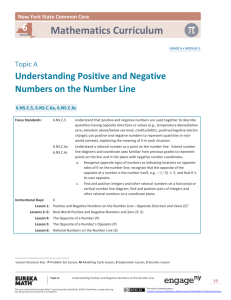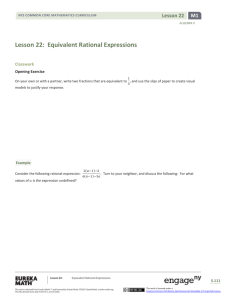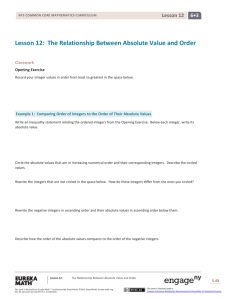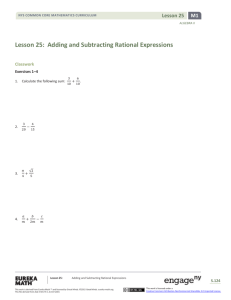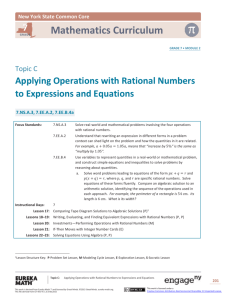Grade 6 Mathematics Module 3, Topic B, Lesson 7
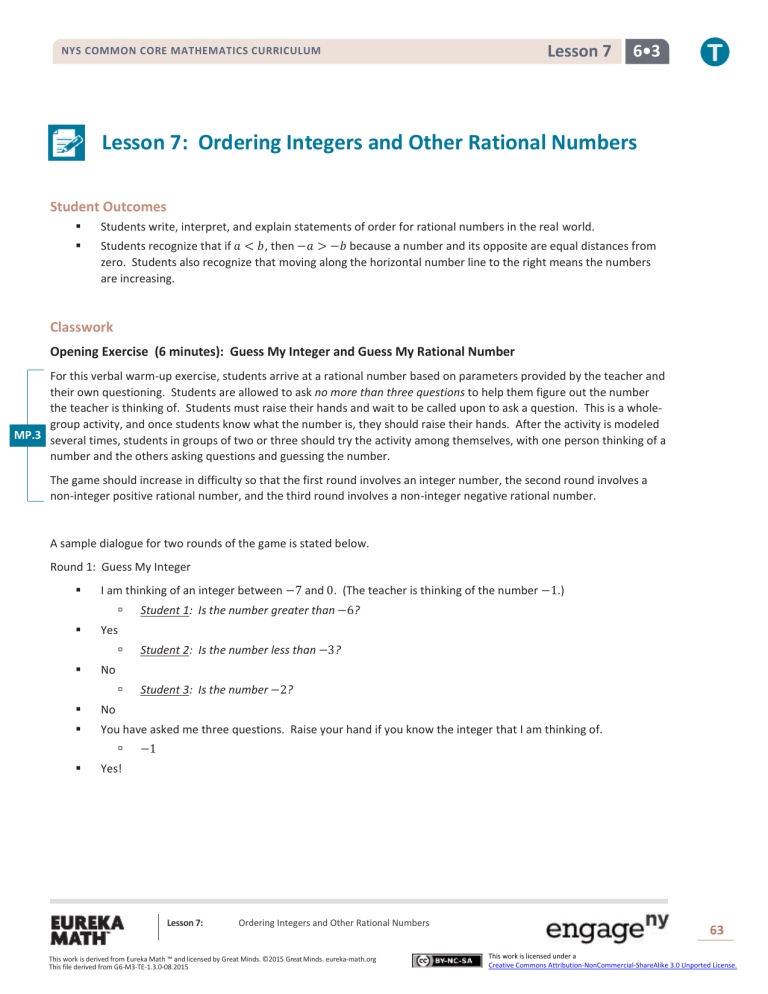
NYS COMMON CORE MATHEMATICS CURRICULUM Lesson 7 6•3
Lesson 7: Ordering Integers and Other Rational Numbers
Student Outcomes
Students write, interpret, and explain statements of order for rational numbers in the real world.
Students recognize that if 𝑎 < 𝑏 , then −𝑎 > −𝑏 because a number and its opposite are equal distances from zero. Students also recognize that moving along the horizontal number line to the right means the numbers are increasing.
Classwork
Opening Exercise (6 minutes): Guess My Integer and Guess My Rational Number
MP.3
For this verbal warm-up exercise, students arrive at a rational number based on parameters provided by the teacher and their own questioning. Students are allowed to ask no more than three questions to help them figure out the number the teacher is thinking of. Students must raise their hands and wait to be called upon to ask a question. This is a wholegroup activity, and once students know what the number is, they should raise their hands. After the activity is modeled several times, students in groups of two or three should try the activity among themselves, with one person thinking of a number and the others asking questions and guessing the number.
The game should increase in difficulty so that the first round involves an integer number, the second round involves a non-integer positive rational number, and the third round involves a non-integer negative rational number.
A sample dialogue for two rounds of the game is stated below.
Round 1: Guess My Integer
I am thinking of an integer between −7 and 0 . (The teacher is thinking of the number −1 .)
Student 1: Is the number greater than −6 ?
Yes
Student 2: Is the number less than −3 ?
No
Student 3: Is the number −2 ?
No
You have asked me three questions. Raise your hand if you know the integer that I am thinking of.
−1
Yes!
Lesson 7: Ordering Integers and Other Rational Numbers
This work is derived from Eureka Math ™ and licensed by Great Minds. ©2015 Great Minds. eureka-math.org
This file derived from G6-M3-TE-1.3.0-08.2015
63
This work is licensed under a
Creative Commons Attribution-NonCommercial-ShareAlike 3.0 Unported License.
NYS COMMON CORE MATHEMATICS CURRICULUM
Round 2: Guess My Positive Non-Integer Rational Number
Lesson 7 6•3
I am thinking of a positive rational number between 1 and 2 . (The teacher is thinking of the number
5
4
.)
No
Student 1: Is the number greater than 1
1
2
?
Yes
Student 2: Is the number less than 1.4
?
Student 3: Is the number less than 1.2
?
No
You have asked me three questions. Raise your hand if you know the rational number that I am thinking of.
No
1.3
No
1.35
1.25
Yes!
Discussion (3 minutes)
If we have two rational numbers that we want to graph on the same number line, how would we describe to someone where each number lies in comparison to the other number?
The lesser number is to the left of (or below) the greater number. (Or the greater number is to the right of [or above] the lesser number.) Negative numbers are to the left of (or below) zero, and positive numbers are to the right of (or above) zero.
Describe the location on the number line of a number and its opposite.
They are both the same distance from zero but on opposite sides of zero.
If we were to list the numbers from least to greatest, which would be farthest to the left on the number line?
Why? Which would be farthest to the right? Why?
The numbers on the number line decrease as you move to the left (or down) and increase as you move to the right (or up). So, the number that is the least would be farthest left (or down), and the number that is the greatest would be farthest right (or up).
Lesson 7: Ordering Integers and Other Rational Numbers
This work is derived from Eureka Math ™ and licensed by Great Minds. ©2015 Great Minds. eureka-math.org
This file derived from G6-M3-TE-1.3.0-08.2015
64
This work is licensed under a
Creative Commons Attribution-NonCommercial-ShareAlike 3.0 Unported License.
NYS COMMON CORE MATHEMATICS CURRICULUM
Exercise 1 (5 minutes)
Lesson 7
Allow time for a whole-group discussion to follow completion of the exercise.
Exercise 1 a.
Graph the number 𝟕 and its opposite on the number line. Graph the number 𝟓 and its opposite on the number line.
6•3
MP.2
−𝟏𝟎 −𝟗 −𝟖 −𝟕 −𝟔 −𝟓 −𝟒 −𝟑 −𝟐 −𝟏 𝟎 𝟏 𝟐 𝟑 𝟒 𝟓 𝟔 𝟕 𝟖 𝟗 𝟏𝟎 b.
Where does 𝟕 lie in relation to 𝟓 on the number line?
On the number line, 𝟕 is 𝟐 units to the right of 𝟓 . c.
Where does the opposite of 𝟕 lie on the number line in relation to the opposite of 𝟓 ?
On the number line, −𝟕 is 𝟐 units to the left of −𝟓 . d.
I am thinking of two numbers. The first number lies to the right of the second number on a number line.
What can you say about the location of their opposites? (If needed, refer to your number line diagram.)
On the number line, the opposite of the second number must lie to the right of the opposite of the first number. If we call the first number 𝒇 and the second number 𝒔 , then −𝒇 and −𝒔 will have the opposite order of 𝒇 and 𝒔 because −𝒇 and −𝒔 are opposites of 𝒇 and 𝒔 , so they lie on the opposite side of zero.
Example 1 (4 minutes)
Example 1
The record low temperatures for a town in Maine are −𝟐𝟎°𝐅 for January and −𝟏𝟗°𝐅 for February.
Order the numbers from least to greatest. Explain how you arrived at the order.
Read: January: −𝟐𝟎 and February: −𝟏𝟗
Draw: Draw a number line model.
Write: Since −𝟐𝟎 is farthest below zero and −𝟏𝟗 is above −𝟐𝟎 on the vertical number line, −𝟐𝟎 is less than −𝟏𝟗 .
Answer: −𝟐𝟎 , −𝟏𝟗
Scaffolding:
One potential strategy to use when tackling word problems is the RDW approach, which stands for Read, Draw, and
Write.
𝟎
−𝟏𝟗
−𝟐𝟎
Lesson 7: Ordering Integers and Other Rational Numbers
This work is derived from Eureka Math ™ and licensed by Great Minds. ©2015 Great Minds. eureka-math.org
This file derived from G6-M3-TE-1.3.0-08.2015
65
This work is licensed under a
Creative Commons Attribution-NonCommercial-ShareAlike 3.0 Unported License.
NYS COMMON CORE MATHEMATICS CURRICULUM
Exercises 2–4 (8 minutes)
Lesson 7
Allow time to discuss these problems as a whole class.
Exercises 2–4
For each problem, order the rational numbers from least to greatest by first reading the problem, then drawing a number line diagram, and finally, explaining your answer.
2.
Jon’s time for running the mile in gym class is 𝟗. 𝟐 minutes. Jacky’s time is 𝟗. 𝟏𝟖 minutes. Who ran the mile in less time?
𝟗. 𝟏𝟖 , 𝟗. 𝟐
I drew a number line and graphed 𝟗. 𝟐 and 𝟗. 𝟏𝟖 ; 𝟗. 𝟐 is to the right of 𝟗. 𝟏𝟖 . So, 𝟗. 𝟏𝟖 is less than 𝟗. 𝟐 , which means
Jacky ran the mile in less time than Jon.
3.
Mrs. Rodriguez is a teacher at Westbury Middle School. She gives bonus points on tests for outstanding written answers and deducts points for answers that are not written correctly. She uses rational numbers to represent the points. She wrote the following on students’ papers: Student A: −𝟐 points, Student B: −𝟐. 𝟓 points. Did Student A or Student B perform worse on the test?
−𝟐. 𝟓 , −𝟐
I drew a number line, and −𝟐 and −𝟐. 𝟓 are both to the left of zero, but −𝟐. 𝟓 is to the left of −𝟐 . So, −𝟐. 𝟓 is less than −𝟐 . That means Student B did worse than Student A.
4.
A carp is swimming approximately
𝟑
𝟖
𝟏
𝟒 feet beneath the water’s surface, and a sunfish is swimming approximately
𝟏
𝟐
feet beneath the water’s surface. Which fish is swimming farther beneath the water’s surface?
−𝟖
𝟏
𝟒
, −𝟑
𝟏
𝟐
I drew a vertical number line, and −𝟖
𝟏
𝟒
is farther below zero than −𝟑
carp is swimming farther beneath the water’s surface.
𝟏
𝟐
. So, −𝟖
𝟏
𝟒
is less than −𝟑
𝟏
𝟐
, which means the
Example 2 (3 minutes)
Example 2
Henry, Janon, and Clark are playing a card game. The object of the game is to finish with the most points. The scores at the end of the game are Henry: −𝟕 , Janon: 𝟎 , and Clark: −𝟓 . Who won the game? Who came in last place? Use a number line model, and explain how you arrived at your answer.
Read: Henry: −𝟕 , Janon: 𝟎 , and Clark: −𝟓
Draw:
6•3
−𝟏𝟎 −𝟗 −𝟖 −𝟕 −𝟔 −𝟓 −𝟒 −𝟑 −𝟐 −𝟏 𝟎 𝟏 𝟐 𝟑 𝟒 𝟓 𝟔 𝟕 𝟖 𝟗 𝟏𝟎
Explain: −𝟕 , −𝟓 , 𝟎
Janon won the game, and Henry came in last place. I ordered the numbers on a number line, and −𝟕 is farthest to the left. That means −𝟕 is the smallest of the three numbers, so Henry came in last place. Next on the number line is −𝟓 , which is to the right of −𝟕 but to the left of 𝟎 . Farthest to the right is 𝟎 ; therefore, 𝟎 is the greatest of the three numbers. This means Janon won the game.
Lesson 7: Ordering Integers and Other Rational Numbers
This work is derived from Eureka Math ™ and licensed by Great Minds. ©2015 Great Minds. eureka-math.org
This file derived from G6-M3-TE-1.3.0-08.2015
66
This work is licensed under a
Creative Commons Attribution-NonCommercial-ShareAlike 3.0 Unported License.
NYS COMMON CORE MATHEMATICS CURRICULUM
Exercises 5–6 (6 minutes)
Lesson 7
Exercises 5–6
For each problem, order the rational numbers from least to greatest by first reading the problem, then drawing a number line diagram, and finally, explaining your answer.
5.
Henry, Janon, and Clark are playing another round of the card game. Their scores this time are as follows:
Clark: −𝟏 , Janon: −𝟐 , and Henry: −𝟒 . Who won? Who came in last place?
−𝟒 , −𝟐 , −𝟏
Clark won the game, and Henry came in last place. I ordered the numbers on a number line, and −𝟒 is farthest to the left. That means −𝟒 is the smallest of the three numbers, so Henry lost. Next on the number line is −𝟐 , which is to the right of −𝟒 and to the left of −𝟏 . Farthest to the right is −𝟏 , which is the greatest of the three negative numbers, so Clark won the game.
6.
Represent each of the following elevations using a rational number. Then, order the numbers from least to greatest.
Cayuga Lake
Mount Marcy
New York Stock Exchange Vault
𝟏𝟐𝟐 meters above sea level
𝟏, 𝟔𝟐𝟗
𝟏𝟓. 𝟐𝟒
meters above sea level
meters below sea level
−𝟏𝟓. 𝟐𝟒 ; 𝟏𝟐𝟐 ; 𝟏, 𝟔𝟐𝟗
I drew a number line, and −𝟏𝟓. 𝟐𝟒 is the only number to the left of zero, so it is the least (because as you move to the right, the numbers increase). Next on the number line is 𝟏𝟐𝟐 , which is to the right of zero. Last on the number line is 𝟏, 𝟔𝟐𝟗 , which is to the right of 𝟏𝟐𝟐 , so 𝟏, 𝟔𝟐𝟗 meters is the greatest elevation.
6•3
Closing (5 minutes): What Is the Value of Each Number, and Which Is Larger?
This Closing is a verbal game similar to the Opening Exercise. However, instead of asking questions, students use the two clues the teacher provides and, as a visual model, the number line diagram in their materials. Using the clues and the number line, students determine the value of each number and which number is greater. When a student raises his hand and is called upon, he states the values and which is greater.
Listed below are five rounds of potential questions.
Round 1: The first number is units to the left of
4 . What is the value of each number, and which is greater?
First Number: 2
3 units to the right of
; Second Number: −1 ; 2
−1 . The second number is
is greater than −1 .
5
Scaffolding:
Some students need to rely on the number line for this activity. Others do not, as they have moved from the pictorial to the abstract stage.
Adjust the wait time and difficulty level of the questions to meet the needs of learners. Round 2: The first number is neither positive nor negative. The second number is 1 unit to the left of −1 . What is the value of each number, and which is greater?
First Number: 0 ; Second Number: −2 ; 0 is greater than −2 .
Round 3: The first number is 8
1
2
units to the right of −5 . The second number is 3 units to the right of 0 . What is the value of each number, and which is greater?
First Number: 3.5
; Second Number: 3 ; 3.5
is greater than 3 .
Lesson 7: Ordering Integers and Other Rational Numbers
This work is derived from Eureka Math ™ and licensed by Great Minds. ©2015 Great Minds. eureka-math.org
This file derived from G6-M3-TE-1.3.0-08.2015
67
This work is licensed under a
Creative Commons Attribution-NonCommercial-ShareAlike 3.0 Unported License.
NYS COMMON CORE MATHEMATICS CURRICULUM Lesson 7 6•3
Round 4: The first number is
1
4
unit to the left of −7 . The second number is 8 units to the left of 1 . What is the value of each number, and which is greater?
First Number: −7.25
; Second Number: −7 ; −7 is greater than −7.25
.
Round 5: The opposite of the first number is 2 units to the right of 3 . The opposite of the second number is 2 units to the left of −3 . What is the value of each number, and which is greater?
First Number: −5 ; Second Number: 5 ; 5 is greater than −5.
Closing: What Is the Value of Each Number, and Which Is Larger?
Use your teacher’s verbal clues and this number line to determine which number is larger.
Exit Ticket (5 minutes)
−𝟖 −𝟕 −𝟔 −𝟓 −𝟒 −𝟑 −𝟐 −𝟏 𝟎 𝟏 𝟐 𝟑 𝟒 𝟓 𝟔 𝟕 𝟖
Lesson 7: Ordering Integers and Other Rational Numbers
This work is derived from Eureka Math ™ and licensed by Great Minds. ©2015 Great Minds. eureka-math.org
This file derived from G6-M3-TE-1.3.0-08.2015
68
This work is licensed under a
Creative Commons Attribution-NonCommercial-ShareAlike 3.0 Unported License.
NYS COMMON CORE MATHEMATICS CURRICULUM
Name
Lesson 7 6•3
Date
Lesson 7: Ordering Integers and Other Rational Numbers
Exit Ticket
In math class, Christina and Brett are debating the relationship between two rational numbers. Read their claims below, and then write an explanation of who is correct. Use a number line model to support your answer.
Christina’s Claim: “I know that 3 is greater than 2
1
2
. So, −3 must be greater than −2
1
2
.”
Brett’s Claim: “Yes, 3 is greater than 2
1
2
, but when you look at their opposites, their order will be opposite. So, that means −2
1
2
is greater than −3 .”
Lesson 7: Ordering Integers and Other Rational Numbers
This work is derived from Eureka Math ™ and licensed by Great Minds. ©2015 Great Minds. eureka-math.org
This file derived from G6-M3-TE-1.3.0-08.2015
69
This work is licensed under a
Creative Commons Attribution-NonCommercial-ShareAlike 3.0 Unported License.
NYS COMMON CORE MATHEMATICS CURRICULUM
Exit Ticket Sample Solutions
Lesson 7
In math class, Christina and Brett are debating the relationship between two rational numbers. Read their claims below, and then write an explanation of who is correct. Use a number line model to support your answer.
Christina’s Claim: “I know that 𝟑 is greater than 𝟐
𝟏
𝟐
. So, −𝟑 must be greater than −𝟐
𝟏
𝟐
.”
Brett’s Claim: “Yes, 𝟑 is greater than 𝟐
𝟏
𝟐
, but when you look at their opposites, their order will be opposite. So, that means −𝟐
𝟏
𝟐
is greater than −𝟑 .”
6•3
−𝟒 −𝟑 −𝟐 −𝟏 𝟎 𝟏 𝟐 𝟑 𝟒
Brett is correct. I graphed the numbers on the number line, and −𝟑 is to the left of −𝟐
𝟏
𝟐
. The numbers increase as you move to the right, so −𝟐
𝟏
𝟐 is greater than −𝟑 .
Problem Set Sample Solutions
1.
In the table below, list each set of rational numbers in order from least to greatest. Then, list their opposites.
Finally, list the opposites in order from least to greatest. The first example has been completed for you.
Rational Numbers
−𝟕. 𝟏 , −𝟕. 𝟐𝟓
𝟏
𝟒
, −
𝟏
𝟐
𝟐 , −𝟏𝟎
𝟎 , 𝟑
𝟏
𝟐
−𝟓 , −𝟓. 𝟔
𝟐𝟒
𝟏
𝟐
, 𝟐𝟒
−𝟗𝟗. 𝟗 , −𝟏𝟎𝟎
Ordered from Least to
Greatest
−𝟕. 𝟐𝟓 , −𝟕. 𝟏
−
𝟏
𝟐
,
𝟏
𝟒
−𝟏𝟎 , 𝟐
𝟎 , 𝟑
𝟏
𝟐
−𝟓. 𝟔 , −𝟓
𝟐𝟒 , 𝟐𝟒
𝟏
𝟐
−𝟏𝟎𝟎 , −𝟗𝟗. 𝟗
Opposites
𝟕. 𝟐𝟓 , 𝟕. 𝟏
𝟏
𝟐
, −
𝟏
𝟒
𝟏𝟎 , −𝟐
𝟎 , −𝟑
𝟏
𝟐
𝟓. 𝟔 , 𝟓
−𝟐𝟒 , −𝟐𝟒
𝟏
𝟐
𝟏𝟎𝟎 , 𝟗𝟗. 𝟗
Opposites Ordered from
Least to Greatest
𝟕. 𝟏 , 𝟕. 𝟐𝟓
−
𝟏
𝟒
,
𝟏
𝟐
−𝟐 , 𝟏𝟎
−𝟑
𝟏
𝟐
, 𝟎
𝟓 , 𝟓. 𝟔
−𝟐𝟒
𝟏
𝟐
, −𝟐𝟒
𝟗𝟗. 𝟗 , 𝟏𝟎𝟎
−𝟎. 𝟎𝟓 , −𝟎. 𝟓
−𝟎. 𝟕 , 𝟎
−𝟎. 𝟓 , −𝟎. 𝟎𝟓
−𝟎. 𝟕 , 𝟎
𝟎. 𝟓 ,
𝟎. 𝟕
𝟎. 𝟎𝟓
, 𝟎
𝟎. 𝟎𝟓
𝟎 ,
, 𝟎. 𝟓
𝟎. 𝟕
𝟏𝟎𝟎. 𝟎𝟐 , 𝟏𝟎𝟎. 𝟎𝟒 𝟏𝟎𝟎. 𝟎𝟐 , 𝟏𝟎𝟎. 𝟎𝟒 −𝟏𝟎𝟎. 𝟎𝟐 , −𝟏𝟎𝟎. 𝟎𝟒 −𝟏𝟎𝟎. 𝟎𝟒 , −𝟏𝟎𝟎. 𝟎𝟐
2.
For each row, what pattern do you notice between the numbers in the second and fourth columns? Why is this so?
For each row, the numbers in the second and fourth columns are opposites, and their order is opposite. This is because on the number line, as you move to the right, numbers increase. But as you move to the left, the numbers decrease. So, when comparing 𝟓 and 𝟏𝟎 , 𝟏𝟎 is to the right of 𝟓 ; therefore, 𝟏𝟎 is greater than 𝟓 . However, −𝟏𝟎 is to the left of −𝟓 ; therefore, −𝟏𝟎 is less than −𝟓 .
Lesson 7: Ordering Integers and Other Rational Numbers
This work is derived from Eureka Math ™ and licensed by Great Minds. ©2015 Great Minds. eureka-math.org
This file derived from G6-M3-TE-1.3.0-08.2015
70
This work is licensed under a
Creative Commons Attribution-NonCommercial-ShareAlike 3.0 Unported License.
